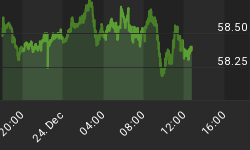Below is an extract from a commentary originally posted at www.speculative-investor.com on 17th February 2008.
We compare, below, charts of the TYX/FVX ratio (the yield on the 30-yr T-Bond divided by the yield on the 5-yr T-Note) and the HUI/gold ratio (gold stocks relative to gold bullion). With the charts offset by about 6 months it is readily apparent that the HUI/gold ratio's major upward reversal in November of 2000 lagged a similar upward reversal in the TYX/FVX ratio by about 6 months, and that the HUI/gold ratio's major downward reversal in December of 2003 lagged a similar downward reversal in the TYX/FVX ratio, again by about 6 months. In other words, the huge 2000-2003 upward move in gold stocks relative to gold bullion can be explained by the preceding performance of the US yield-spread.
Since late 2003 the gold sector of the stock market has been in consolidation relative to gold bullion, but the rapid widening of the US yield-spread over the past 6 months -- as indicated on our chart by the sharp rise in the TYX/FVX ratio -- suggests that this lengthy consolidation will soon come to an end. To be more specific, it suggests that the gold sector of the stock market will soon commence a multi-quarter, or perhaps even a multi-year, rally relative to gold bullion.
Note that "soon", here, doesn't necessarily mean next week or next month. HUI/gold lagged the yield-spread by 6 months at major turning points during the first few years of the bull market, but we shouldn't assume that exactly the same lag-time remains applicable today. Due to other factors -- the performance of the currency market, for instance -- the lag might be more like 9-10 months this time round. The point we wanted to make is that the yield-spread is putting considerable upward pressure on the gold sector. Other factors have recently been counteracting this upward pressure and could continue to do so for a while longer, but it is reasonable to expect that a substantial advance in the gold sector of the stock market -- both in nominal currency terms and relative to gold bullion -- will begin within the next few months.

The junior end of the gold sector remains in the doldrums, but as we discussed in the 4th February Weekly Update the juniors can't be expected to do much until after the majors and mid-tiers have become persistently strong. As a group, the larger-cap gold stocks did quite well for about three months beginning in mid August, but since early November they have been sluggish despite significant additional gains in the gold price.
The gold sector's lacklustre performance is epitomised by the following charts. The top chart shows that the Newmont Mining (NEM) stock price rebounded strongly during the months following its August-2007 bottom, but remains well below its 2006 peak. The bottom chart shows that NEM's performance relative to gold has been terrible over the past few years. The NEM/gold ratio is actually nearing the major low reached in November of 2000 -- at the very beginning of the gold sector's long-term bull market.
NEM has obviously been a bad investment relative to gold bullion over the past few years, but the fact that it has fallen to such a low level relative to gold lends weight to our conclusion, drawn from the chart comparison presented above, that within the next few months the gold sector will commence a major rally in gold terms as well as in nominal currency terms.

















